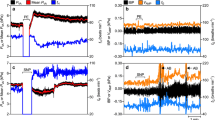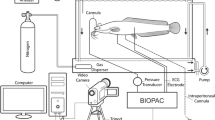Abstract
Most teleost fish reduce heart rate when exposed to acute hypoxia. This hypoxic bradycardia has been characterised for many fish species, but it remains uncertain whether this reflex contributes to the maintenance of oxygen uptake in hypoxia. Here we describe the effects of inhibiting the bradycardia on oxygen consumption (MO2), standard metabolic rate (SMR) and the critical oxygen partial pressure for regulation of SMR in hypoxia (Pcrit) in European eels Anguilla anguilla (mean ± SEM mass 528 ± 36 g; n = 14). Eels were instrumented with a Transonic flow probe around the ventral aorta to measure cardiac output (Q) and heart rate (f H). MO2 was then measured by intermittent closed respirometry during sequential exposure to various levels of increasing hypoxia, to determine Pcrit. Each fish was studied before and after abolition of reflex bradycardia by intraperitoneal injection of the muscarinic antagonist atropine (5 mg kg−1). In the untreated eels, f H fell from 39.0 ± 4.3 min−1 in normoxia to 14.8 ± 5.2 min−1 at the deepest level of hypoxia (2 kPa), and this was associated with a decline in Q, from 7.5 ± 0.8 mL min−1 kg−1 to 3.3 ± 0.7 mL min−1 kg−1 in normoxia versus deepest hypoxia, respectively. Atropine had no effect on SMR, which was 16.0 ± 1.8 μmol O2 kg−1 min−1 in control versus 16.8 ± 0.8 μmol O2 kg−1 min−1 following treatment with atropine. Atropine also had no significant effect on normoxic f H or Q in the eel, but completely abolished the bradycardia and associated decline in Q during progressive hypoxia. This pharmacological inhibition of the cardiac responses to hypoxia was, however, without affect on Pcrit, which was 11.7 ± 1.3 versus 12.5 ± 1.5 kPa in control versus atropinised eels, respectively. These results indicate, therefore, that reflex bradycardia does not contribute to maintenance of MO2 and regulation of SMR by the European eel in hypoxia.




Similar content being viewed by others
References
Burleson ML, Smatresk NJ, Milsom WK (1992) In: Hoar WS, Randall DJ (eds) Afferent inputs associated with cardioventilatory control in fish. Fish Physiology, vol 12B. Academic Press, New York, pp 390–426
Butler PJ, Taylor EW (1971) Response of the dogfish (Scyliorhinus canicula) to slowly induced and rapidly induced hypoxia. Comp Biochem Physiol 39A:307–323
Chapman LJ, Kaufman LS, Chapman CA, McKenzie FE (1995) Hypoxia tolerance in twelve species of East African cichlids: potential for low oxygen refugia in Lake Victoria. Cons Biol 9:1274–1288
Chapman LL, McKenzie DJ (2009) Behavioural responses and ecological consequences. In: Richards JJ, Brauner CJ, Farrell AP (eds) Hypoxia. Fish Physiology, vol 27. Academic Press/Elsevier, San Diego, California, pp 26–77
Cruz-Neto AP, Steffensen JF (1997) The effects of acute hypoxia and hypercapnia on the oxygen consumption of the freshwater European eel. J Fish Biol 50:759–769
Degani G, Gallagher ML, Meltzer A (1989) The influence of body size and temperature on oxygen consumption of the European eel, Anguilla anguilla L. J Fish Biol 34:19–24
Farrell AP (2007) Tribute to P.L. Lutz: a message from the heart—why hypoxic bradycardia in fishes? J Exp Biol 210:1715–1725
Farrell AP, Daxboeck C, Randall DJ (1979) The effect of input pressure and flow on the pattern and resistance to flow in the isolated perfused gill of a teleost fish. Comp Biochem physiol 133:233–240
Farrell AP, Sobin SS, Randall DJ, Crosby S (1980) Intralamellar blood flow patterns in fish gills. Am J Physiol 239:R428–R436
Hughes GM, Peyraud C, Peyraud-Waitezenegger M, Soulier P (1982) Physiological evidence for the occurrence of pathways shunting blood away from the secondary lamellae of eel gills. J Exp Biol 98:277–288
Le Moigne J, Soulier P, Peyraud-Waitzenegger M, Peyraud C (1986) Cutaneous and gill O2 uptake in the European eel (Anguilla anguilla L.) in relation to ambient PO2, 10–4000 Torr. Respir Physiol 66:341–354
Marvin DE, Heath AG (1968) Cardiac and respiratory responses to gradual hypoxia in 3 ecological distinct species of fresh-water fish. Comp Biochem Physiol 27:349
McKenzie DJ, Taylor EW, Bronzi P, Bolis L (1995) Aspects of cardioventilatory control in the adriatic sturgeon (Acipenser naccarii). Respir Physiol 100:44–52
McKenzie DJ, Piraccini G, Piccolella M, Steffensen JF, Bolis CL, Taylor EW (2000) Effects of dietary fatty acid composition on metabolic rate and responses to hypoxia in the European eel (Anguilla anguilla). Fish Physiol Biochem 22:281–296
McKenzie DJ, Dalla Valle AZ, Taylor EW, Steffensen JF (2002) Tolerance of acute hypercapnic acidosis by the European eel (Anguilla anguilla). J Comp Physiol B 172:339–346
McKenzie DJ, Dalla Valle AZ, Piccolella M, Taylor EW, Steffensen JF (2003) Tolerance of chronic hypercapnia by the European eel (Anguilla anguilla). J Exp Biol 206:1717–1726
McKenzie DJ, Skov PV, Taylor EW, Wang T, Steffensen JF (2009) Abolition of hypoxic bradycardia by cardiac vagotomy has no effect on regulation of oxygen uptake in Atlantic cod Gadhus morhu. Comp Biochem Physiol A 153:332–338
McWilliam JA (1884–1885) On the structure and rhythm if the heart in fishes, with especial reference to the heart of the eel. P Roy Soc Lond 8:108–129
Pennec J-P, Le Bras Y-M (1988) Diel and seasonal rythms of the heart rate in the common eel (Anguilla anguilla L.): role of cardiac innervations. J Exp Biol 47:155–160
Perry SF, Desforges PR (2006) Does bradycardia or hypertension enhance gas transfer in rainbow trout (Oncorhynchus mykiss). Comp Biochem Physiol 144A:163–172
Perry SF, Reid SG (2002) Cardiorespiratory adjustments during hypercarbia in rainbow trout (Oncorhynchus mykiss) are initiated by external CO2 receptors on the first gill arch. J Exp Biol 205:3356–3357
Peyraud-Waitzenegger M, Soulier P (1989) Ventilatory and circulatory adjustments in the European eel (Anguilla anguilla L.) exposed to short term hypoxia. J Exp Biol 48:107–122
Randall DJ (1982) The control of respiration and circulation in fish during exercise and hypoxia. J Exp Biol 100:275–288
Randall D, Daxboeck CR (1984) Oxygen and carbon dioxide transfer across fish gills. In: Hoar WS, Randall DJ (eds) Fish physiology, vol XA. Academic Press, New York, pp 263–314
Randall DJ, Shelton G (1963) The effects of changes in environmental gas concentrations on the breathing and heart rate of a teleost fish. Comp Biochem Physiol 9:229–239
Rantin FT, Kalinin AL, Guerra CDR, Maricondi-Massari M, Verzola RMM (1995) Electrocardiographic characterization of myocardial function in normoxic and hypoxic teleost. Braz J Med Biol Res 28:1277–1289
Reid SG, Perry SF, Gilmour KM, Milsom WK, Rantin FT (2006) Reciprocal modulation of O2 and CO2 cardiorespiratory chemoreflexes in the tambaqui. Respir Physiol Neurobiol 146:175–194
Schurmann H, Steffensen JF (1997) Effects of temperature, hypoxia and activity on the metabolism of juvenile Atlantic cod. J Fish Biol 50:1166–1180
Sébert P, Péqueux A, Simon B, Barthélémy L (1995) Effects of hydrostatic pressure and temperature on the energy metabolism of the Chinese crab (Eriocheir sinensis) and the yellow eel (Anguilla anguilla). Comp Biochem Physiol A 112:131–136
Short S, Taylor EW, Butler PJ (1979) The effectiveness of oxygen transfer during normoxia and hypoxia in the dogfish (Scyliorhinus canicula L.) before and after cardiac vagotomy. J Comp Physiol Biol 132:289–295
Soulier P, Peyraud-Waitzenegger M, Peyraud C, Barthelemy L (1988) A study of barosensitivity in the european Eel (Anguilla anguilla, L.): effects of aterial pressure changes on the heart rate and ventilation. J Exp Biol 47:243–250
Steffensen JF (1989) Some errors in the respirometry of aquatic breathers: how to avoid and correct for them. Fish Physiol Biochem. 6:49–59
Steffensen JF (2007) Oxygen consumption of fish exposed to hypoxia: are they all oxyregulators or are any oxyconformers? In: Brauner CJ, Suvajdzic K, Nilsson G, Randall DJ (eds) Fish physiology, fish toxicology and fisheries management: proceedings of the 9th international symposium. Ecosystem Research Division Publication EPA/600/R-07/010. United States of Envrionmental Protection Agency, Athens, Georgia, pp 237–248
Sundin L, Burleson ML, Sanchez AR, Amin-Naves J, Kinkead R, Gargaglioni LH, Hartzler LK, Wiemann M, Kumar P, Glass ML (2007) Respiratory chemoreceptor function in vertebrates—comparative and evolutionary aspects. Integr Comp Biol 47:592–600
Taylor EW (1985) Control and coordination of gill ventilation and perfusion. J Exp Biol 100:289–319
Taylor EW (1992) Nervous control of the heart and cardiorespiratory interactions. In: Hoar WS, Randall DJ, Farrell AP (eds) Fish physiology. The cardiovascular system. Academic Press, San Diego, pp 343–387
Taylor EW, Barrett DJ (1985) Evidence of a respiratory role for the hypoxic bradycardia in the dogfish Scyliorhinus canicula L. Comp Biochem Physiol A 80:99–102
Taylor EW, Short S, Butler PJ (1977) The role of the cardiac vagus in the response of the dogfish Scyliorhinus canicula to hypoxia. J Exp Biol 70:57–75
Wood CM, McMahon BR, McDonald DG (1979) The influence of temperature and anemia on the adrenergic and cholinergic mechanisms controlling heart rate in the rainbow trout. Can J Zool 57:2440–2447
Acknowledgments
This study was supported by the Danish Research Council. The authors are grateful to two anonymous reviewers for constructive criticism.
Author information
Authors and Affiliations
Corresponding author
Additional information
Communicated by H. V. Carey.
Rights and permissions
About this article
Cite this article
Iversen, N.K., McKenzie, D.J., Malte, H. et al. Reflex bradycardia does not influence oxygen consumption during hypoxia in the European eel (Anguilla anguilla). J Comp Physiol B 180, 495–502 (2010). https://doi.org/10.1007/s00360-009-0428-3
Received:
Revised:
Accepted:
Published:
Issue Date:
DOI: https://doi.org/10.1007/s00360-009-0428-3




